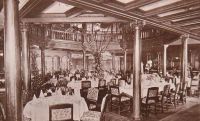While we usually do not go for the proverbial
"teeny tiny" pieces of artifacts floating around in today's market, this one was an exception because of how interesting it
is, even if it is not exact.
Displayed above is a 1" by 1" fragment of a 6" Pilkington Persian-style
designed by John Chambers for use onboard the Turkish Bath Cooling Rooms of the RMS Titanic and RMS Olympic
in 1911. Parks Stephenson is a well-known historian on the interior of these rooms and has worked with Ken Marschall
on the above computer rendering. When asked about these tiles in 2007, Mr. Stephenson gave the following answer
on Encyclopedia Titanica:
Pilkington did indeed design the tiles used in Titanic's Turkish Bath
and the example above is consistent with the pattern seen inside the wreck. The only difference are the colours used...this
same pattern was used in many applications, with variations in colour schemes used to make each one unique. The colour scheme
in the example above is close to, but not an exact reproduction of, the scheme that I personally observed in Titanic's Cooling
Room.
When I first attempted to re-create the tiles for use in my CG model of the Cooling Room, I used a colour scheme
very similar to what is shown here. It matched a 1911 artist's rendering of the room and the Shipbuilder description. However,
when we actually had a look at the actual tiles inside the Titanic wreck, we found that there was less green in the scheme.
At first, I attributed this to fading after years underwater, but other green tiles -- vibrant in colour -- used in the tile
borders argued against this assumption. I concluded that the difference between what we assumed for Olympic and observed in
Titanic can be attributed to the fact that each set of tiles were hand-painted and therefore included some variation.
The
example provided above does not constitute a complete pattern; therefore, the repetition of any one tile does not produce
the overall pattern. When I was building my CG Cooling Room model, I found that no one single tile could be repeated over
and over again to create the overall design. As was pointed out above, the tile work was custom-made for each application.
Titanic's tile work -- in both colour scheme and manner in which the tiles were cut across the pattern -- was therefore similar
to, but not an exact copy of, Olympic's.
The tile pattern that can be seen in the renders from my CG model on my website
represents my second attempt at capturing the correct colour scheme. It is not correct. I have yet to run a render of the
CG model with the observed (re: correct) colour scheme.
- Parks.
Information that came with the piece on its history is as follows.
The previous owner, Margaret Moir, had posession of one tile as she collected Pilkington Pottery and she served on the
Committee of the Piklington Society. Also on this committee was Anthony Cross - reportedly THE expert on Pilkington. Margaret
had planned to sell the tile and he told her of their history and use onboard the great WSL liner's Turkish Baths. He had
discussed the matter with marine archaeologists and confirmed similar tiles found within the wreck. The tile ended up in Austrialia
where it was cut in half. The first half remains as such and the other was sadly cut up into 18 pieces to be sold for
a fraction of what they would have been worth complete. All of the available information was forwarded to us once the tile
fragment switched ownership. Still, it is a beautiful fragment of what the interiors of these liners looked like and still
look like after being submerged for nearly 100 years in the darkness of the Atlantic.

